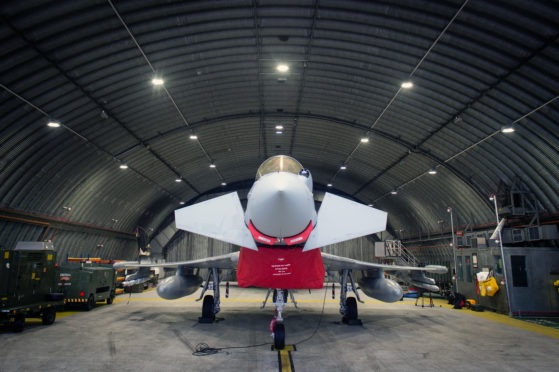The RAF’s highly-skilled pilots and the high-tech aircraft they fly are the most obvious aspect of the UK’s air deterrent.
But behind each of their Quick Reaction Alert missions, as they scramble to intercept other nations’ military planes as they enter our airspace, there are many other vital individuals.
The task of getting the pilot quickly into the aircraft and ensuring a safe take-off is complex and critical.
Before a Typhoon can be launched into the air to tenaciously prowl the skies in search of potential threat, regular maintenance and a series of crucial checks must be carried out.
Flight Lieutenant Zane Sennett says: “We are just one part of a huge team.
“There are so many people working together here at RAF Lossiemouth to get us flying and enable us to protect the skies each and every day.”
The station’s Typhoons are prepared for action by a dedicated team of mechanics, among them Thomas Hastings, aircraft maintenance mechanic for 1 Squadron at RAF Lossie.
There are two Aircraft Mechanics positioned at either side of the aircraft during QRA missions to help launch them as speedily as possible.
Like the pilots, they work around the clock and will continue to aid the effort of keeping the nation safe over Christmas.
Senior Aircraftsman Hastings explained the importance of his role to the efficiency of QRA missions.
“Jets are quite complicated in that in order to get them out and in the air they need to go through a number of start-up procedures,” he said.
“Unlike your car, they take a lot of maintenance just to get them in the air. The aircraft could potentially develop issues at any time and so we always need to be on hand.”
The servicing of intricate and multi-role jet fighter aircraft such as a Typhoon is the daily undertaking of a mechanic, who will carry out three services each day of the year.
Flight Lieutenant Dan Chorley, a communications officer, said: “The mechanics, the chefs, the firefighters, the air traffic controllers – every single one of them has a massive role to play and if you take one out it’s inevitably going to cause ripples across the system.”
Neil Smith, chief communications for Devolved Nations, adds: “When I see the RAF and their fighter pilots it reminds me of the days of old, when knights were bold.
“The aircraft maintenance crew are all those people who get that knight and their steed ready to go into battle.”
As well as the mechanics ensuring the planes take off and land safely, there is the expert team who prepare a personal survival pack for the pilot in the event an emergency ejection is necessary.
They are responsible for maintaining the packs, located under the pilot’s seat, testing the rafts and managing the ejection seat itself, as well as the brake shoot, should the Typhoon need to lose speed rapidly.
This responsibility befalls the station’s survival equipment specialists, one of whom at RAF Lossiemouth is Aiden Hunter.
He says: “It’s very important that everything works exactly as it should.
“Should one of our pilots be forced to eject then we want to ensure they have the best chance of survival, wherever they are.”
Flt Lt Chorley adds: “Survival equipment specialist is a ‘swiss army knife’ of a role.
“They maintain all the survival equipment that the pilot has on them – from the flying suit, the immersion suit, the helmet and gloves, all the way down to their socks.
“It’s all maintained by them.
“They’re a really important but quite often unseen part of the QRA machine.”
